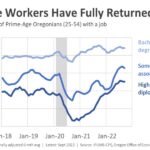BY JOE CORTRIGHT
We get the education we deserve.
BY JOE CORTRIGHT
We get the education we deserve

One of the signature accomplishments of the 2015 legislative session was a bill providing for tuition-free community college for students graduating from Oregon high schools with at least a 2.5 grade-point average.
This bill represents one more step toward expanding educational attainment. For the past several years, Oregon has been pursuing the bold goal of a “40-40-20” — 40% of Oregonians will have a four-year degree or more (it’s 29% now), another 40% a post-high school certificate (18% now) and the remaining 20% a high school diploma or equivalent (13% of Oregonians don’t have a high school diploma today).
{pullquote}Educational attainment is the biggest single factor influencing prosperity. {/pullquote}
Those goals are a stretch, but there are good reasons why we should pursue them aggressively. The one indelible fact of the global, knowledge-driven economy is that educational attainment is the biggest single factor influencing prosperity. The more education citizens acquire, the better their job prospects and income, the more innovative our businesses, the more competitive our economy and the stronger our tax base.
Some will note that many jobs don’t require education beyond high school, and certainly not a four-year degree. They point to forecasts that show the 10 most common occupations in the future will be those that require nothing more than a high school diploma.
And indeed, according to the Oregon Employment Department, over the next decade, the 10 biggest sources of new jobs are projected to be retail salespeople, food-prep workers, waiters, cashiers, nurses, clerks, movers, customer service representatives, nursery and greenhouse workers, and janitors. Only one of these 10 occupations, registered nurse, requires even an associate’s degree for an entry- level job, and seven of the 10 require no specific educational performance.
While these projections may be a useful indicator of where we’re likely to go if we do nothing to up our economic game, they are a poor way of establishing our aspirations.
Consider the parable of two island economies. In 1960 Jamaica and Singapore were British colonies, about to achieve their independence. Both places had about the same levels of per-capita income and about the same levels of education. Few employers were clamoring for education. Over the next few decades, they embarked on very different economic strategies. Jamaica billed itself as a tourism destination and neglected education. Singapore invested massively in the education of its young people. Today the results are striking. Jamaica’s per-capita income is only one-sixth that of Singapore. Singapore is an economic powerhouse in Asia.
This tale of two islands illustrates why it is a mistake to extrapolate from current conditions when setting education objectives. In the long term, an economy can rise or fall to the level of education found in a community.
There’s one thing we know with statistical certainty when it comes to education: More is better. This relationship has become ever stronger over the past few decades. Historically, a high school dropout could get a well-paying job in a mill or factory. Those days are long gone. Repetitive, routine, low-skill work has gone global and no longer commands high wages. Increasingly, the jobs that pay well are those that entail a high level of skill and ability.
And what is true for individuals is true for states. States with well-educated populations have higher levels of income than states with poorly educated populations. The reason Mississippi and
West Virginia are chronically poor and Massachusetts and Maryland have consistently high income has everything to do with the level of education.
And education isn’t just about economic returns; it has a profound influence on public finance. Because of its reliance on the income tax, Oregon gets a disproportionate share of its tax revenue from relatively well-educated persons. And the state’s biggest public-service costs — welfare, corrections and medical care — are disproportionately driven by the number of citizens with the lowest levels of education.
We ought to view the education and skills of our workforce not as a set of minimum requirements that we need to meet but as a decisive asset that can give Oregon a competitive advantage in the global economy. Only if we aim high — by making Oregon’s education standards measurably higher than in competing locations — can we hope to capitalize on this strategy.
The alternative of accepting a lower standard imposes real costs that Oregonians will have to bear for decades. Setting too low a target for the skills of our children creates a real danger that they will be unprepared to compete with new migrants to Oregon. Over the past decade, Oregon’s quality of life has attracted large numbers of highly skilled workers. Many of these migrants bring credentials from top-notch colleges and substantial work experience. Native Oregonians who don’t get a solid education will have a hard time competing for the most desirable jobs.
The economic payback from improving Oregon’s education attainment is enormous. If Oregon today were at the higher attainment levels envisioned in the 40-40-20 plan, the total personal income of Oregonians would be $5 billion higher annually, according to my estimates. Increased attainment would also recast public finance, generating additional tax revenues and lowering the cost of expensive programs in welfare, corrections and the Oregon Health Plan.
The decades ahead will be challenging and unpredictable. Developing projections about the kinds of skills Oregon workers should have is central to thinking about the future. Embracing the minimum poses substantial risks to our well-being. The global economy offers unparalleled opportunities for our state to pioneer new ideas that will make life better not only for us but for many around the world as well. But if we’re to realize the promise, Oregon must aim high.
- Joe Cortright is an economist for Impresa, a Portland consulting firm.
{jcomments on}




